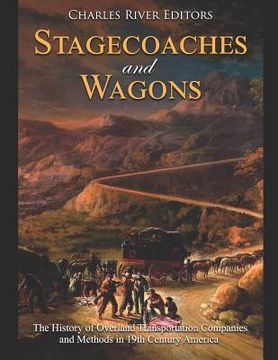Stagecoaches and Wagons: The History of Overland Transportation Companies and Methods in 19th Century America (en Inglés)
Reseña del libro "Stagecoaches and Wagons: The History of Overland Transportation Companies and Methods in 19th Century America (en Inglés)"
*Includes pictures*Includes online resources and a bibliography for further reading"A more uncouth clumsy machine can scarcely be imagined. In the front is a cabriolet fixed to the body of the coach, for the accommodation of three passengers, who are protected from the rain above, by the projecting roof of the coach, and in front by two heavy curtains of leather, well oiled, and smelling somewhat offensively, fastened to the roof. The inside, which is capacious, and lofty, and will hold six people in great comfort is lined with leather padded, and surrounded with little pockets, in which travellers deposit their bread, snuff, night caps, and pocket handkerchiefs, which generally enjoy each others company, in the same delicate depository. From the roof depends a large net work which is generally crouded with hats, swords, and band boxes, the whole is convenient, and when all parties are seated and arranged, the accommodations are by no means unpleasant. Upon the roof, on the outside, is the imperial, which is generally filled with six or seven persons more, and a heap of luggage, which latter also occupies the basket, and generally presents a pile, half as high again as the coach, which is secured by ropes and chains, tightened by a large iron windlass, which also constitutes another appendage of this moving mass. The body of the carriage rests upon large thongs of leather, fastened to heavy blocks of wood, instead of springs, and the whole is drawn by seven horses." - A European tourist's description of a stagecoach in the early 19th centuryThe United States is a massive country, with the continental 48 states covering over three million square miles. From the 13 colonies along the Atlantic Ocean, the nation spread ever westward, and before automobiles, airplanes, and railroads, the most reliable transportation was one's own two feet or a horse. Wagons, whether covered or uncovered, have been used to haul people and supplies for centuries. Roman armies marched with mule-powered wagons, and the Hussites utilized them to form defensive works in warfare. By the time the United States came into existence, wagons were a tried and true method of transportation, and to that end, men and their families expanded westward in wagons and stagecoaches, the automobiles of the era. Driven by oxen, horses, or mules, wagons and stagecoaches allowed people to traverse long distances much faster than walking, and although this form of travel remained relatively slow and perilous, the journey was often considered worth the risk. Some saw the potential profits in moving to the frontier, and as the nation expanded, enterprising individuals sought to form companies dedicated to stagecoach travel. In fact, trails would be forged across the country to help spread settlers, and the westward movement of Americans in the 19th century became one of the largest and most consequential migrations in history. Among the paths that blazed west, the most well-known is the Oregon Trail, which was not a single trail but a network of paths that began at one of four "jumping off" points. These trails branched off at various points and stretched roughly half the country, and hundreds of thousands of settlers would use it, yet the Oregon Trail is famous not so much for its physical dimensions but for what it represented. As many who used the Oregon Trail described in memoirs, the West represented opportunities for adventure, independence, and fortune. The stagecoaches and wagons were the vehicles carrying the supplies and people, making them crucial in shaping the nation. Stagecoaches and Wagons: The History of Overland Transportation Companies and Methods in 19th Century America looks at the vehicles that helped Americans travel across the young country. Along with pictures depicting important people, places, and events, you will learn about stagecoaches and wagons like never before.

